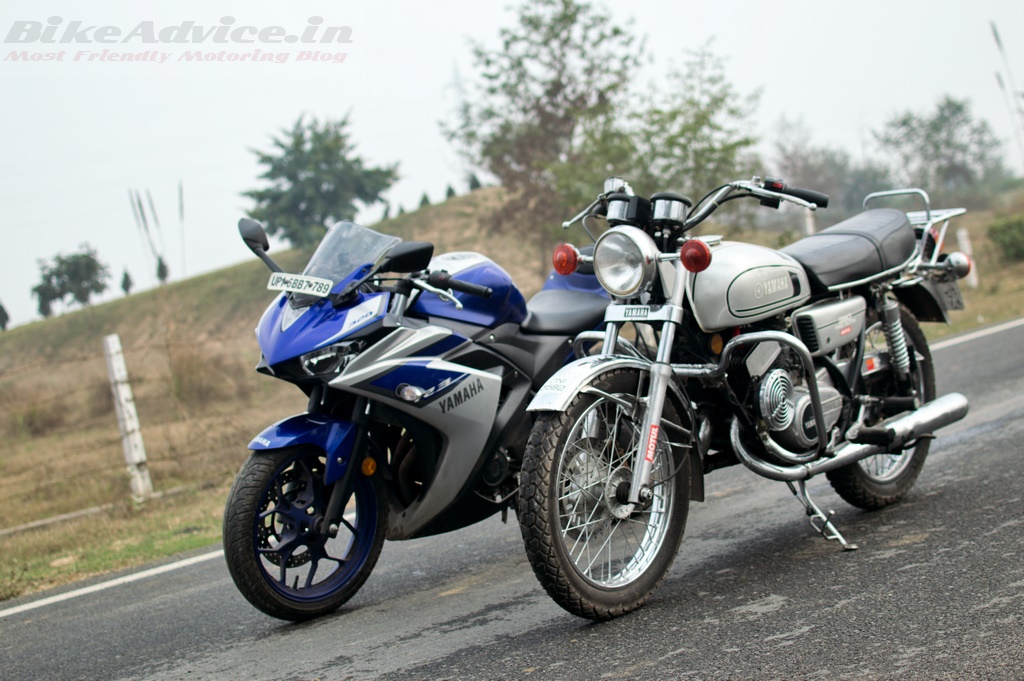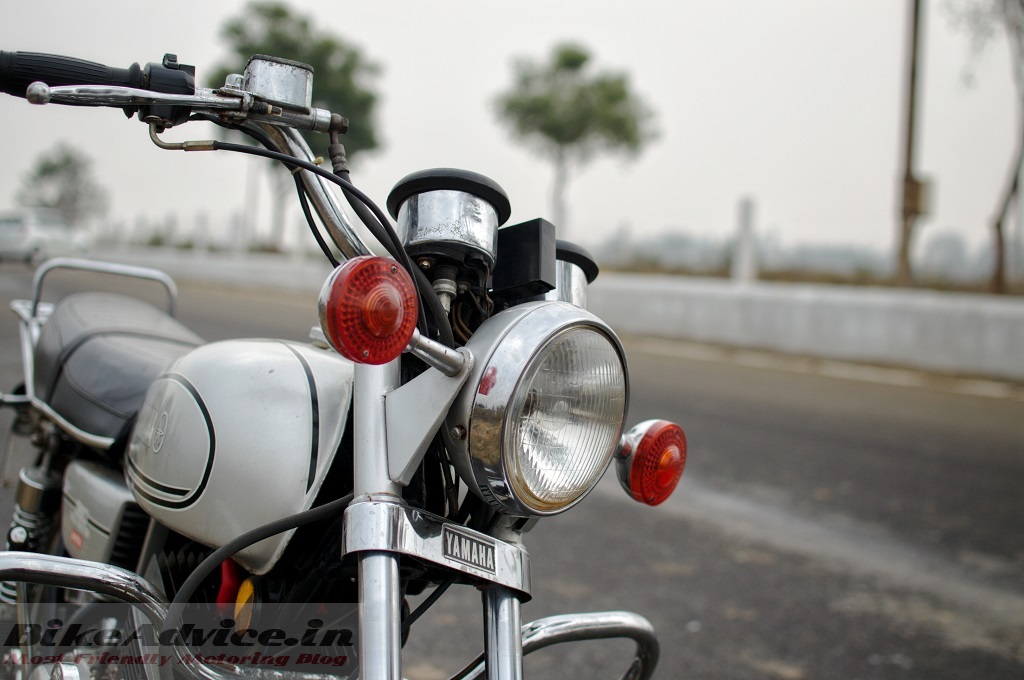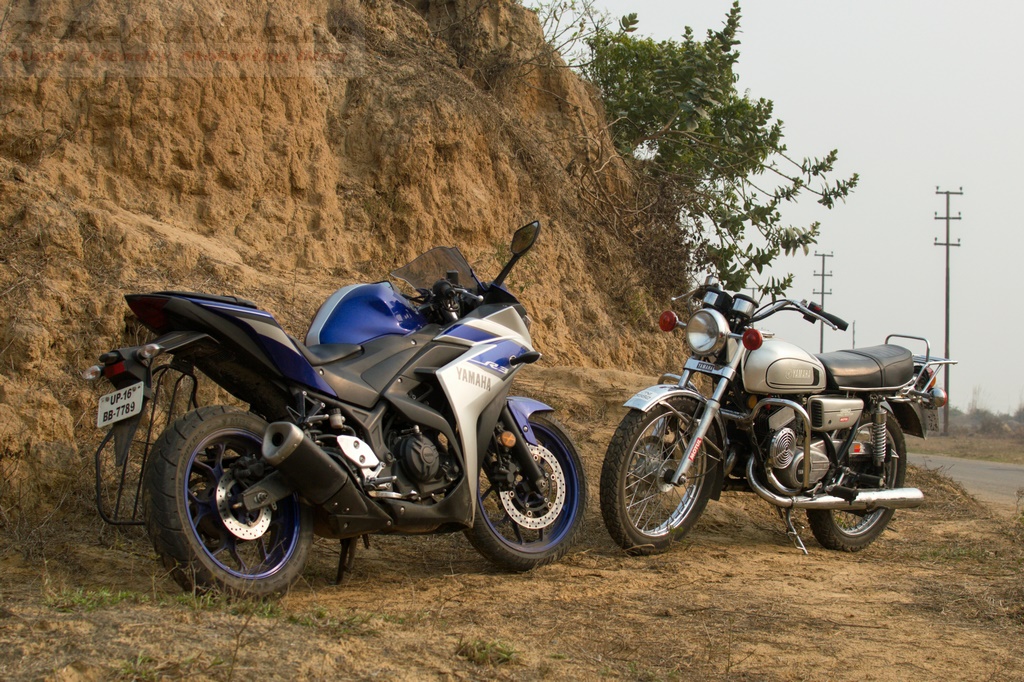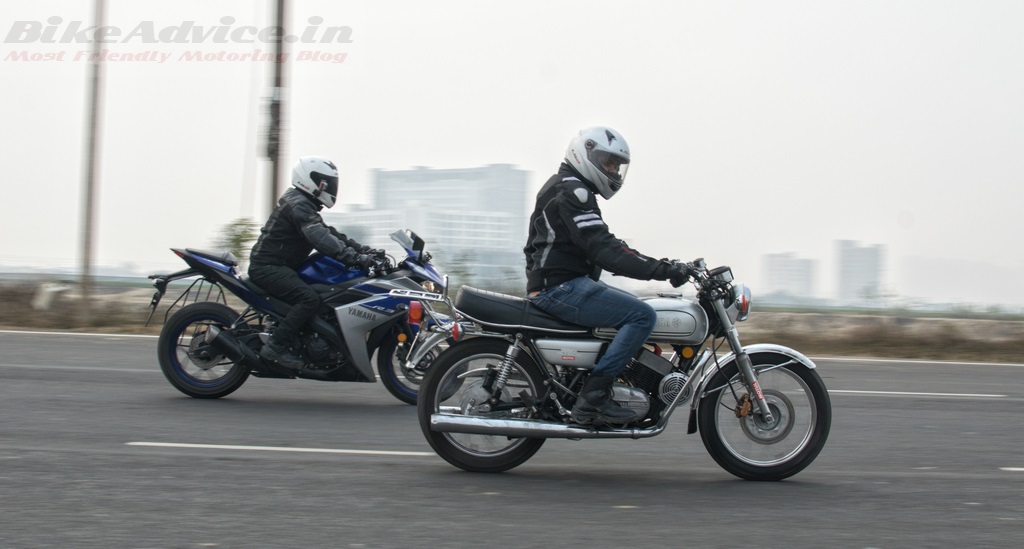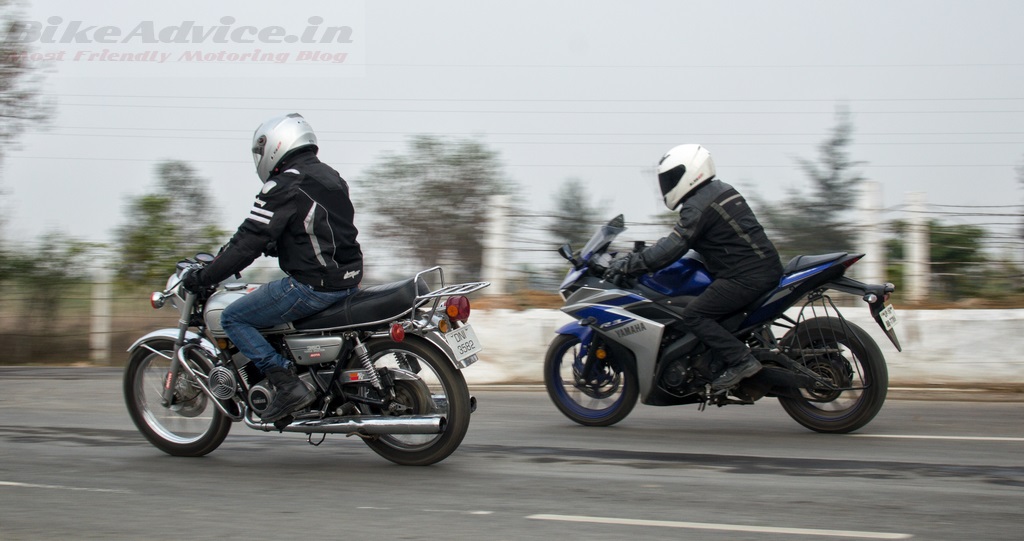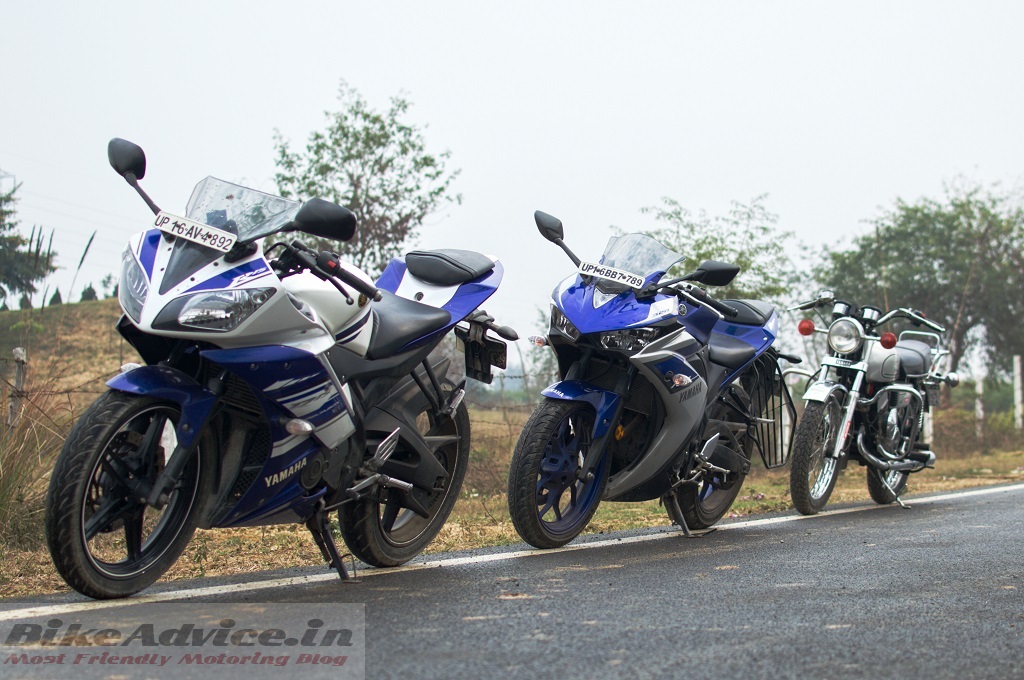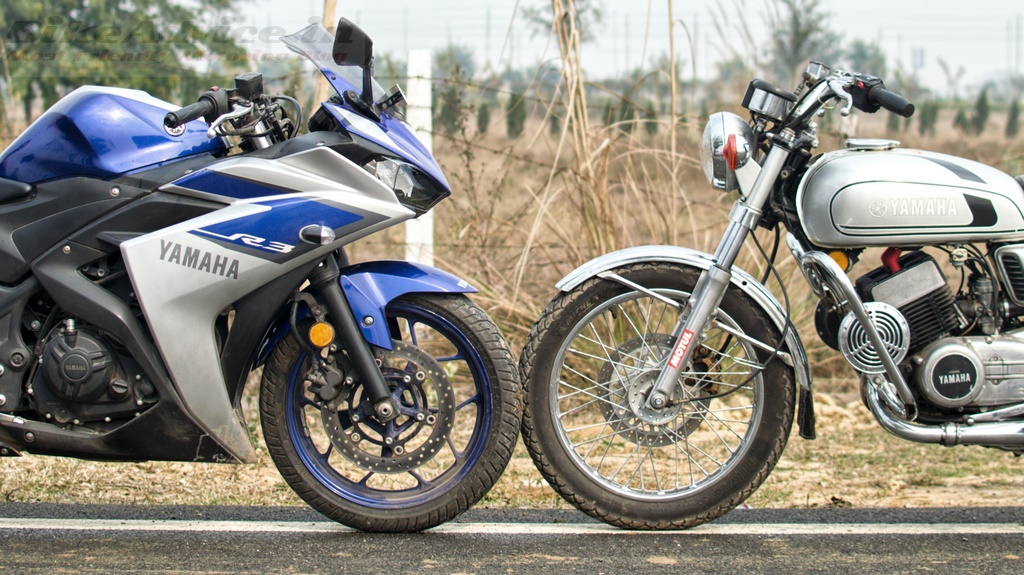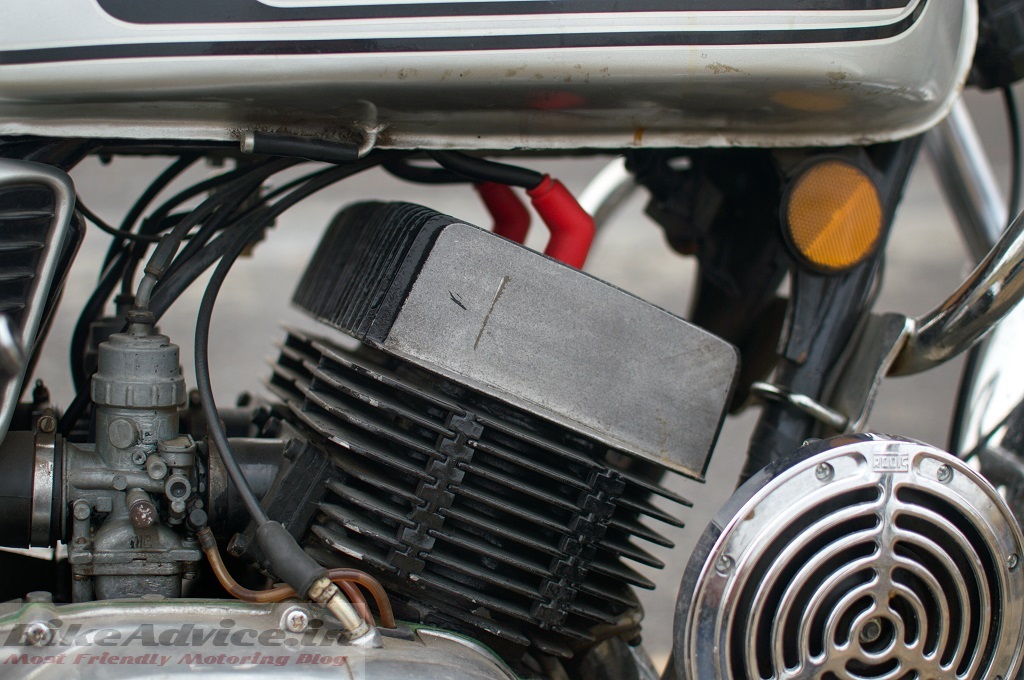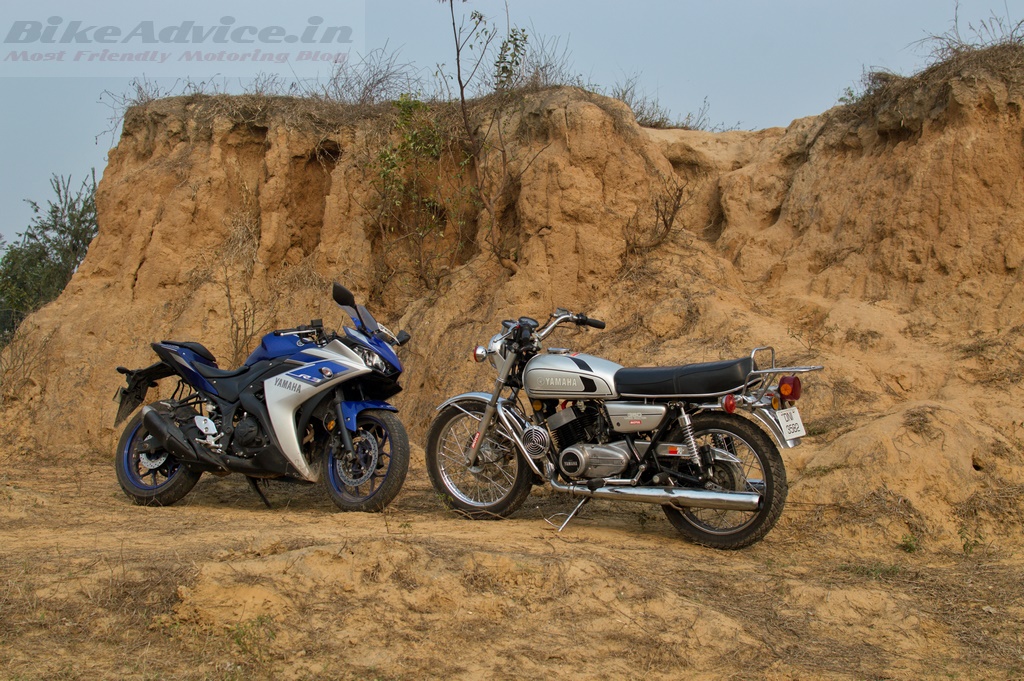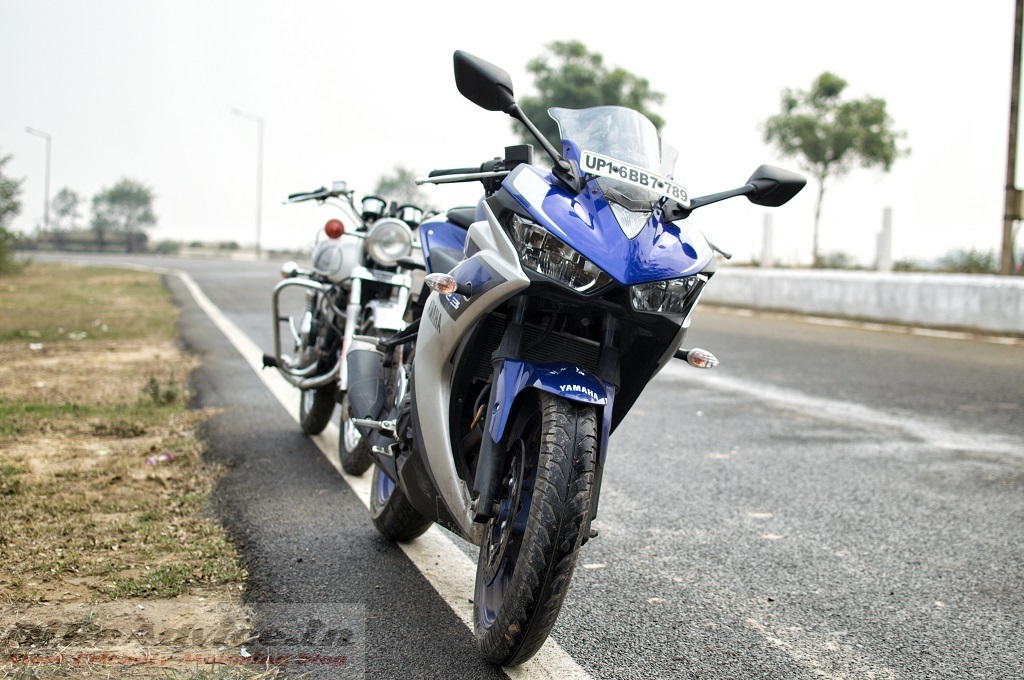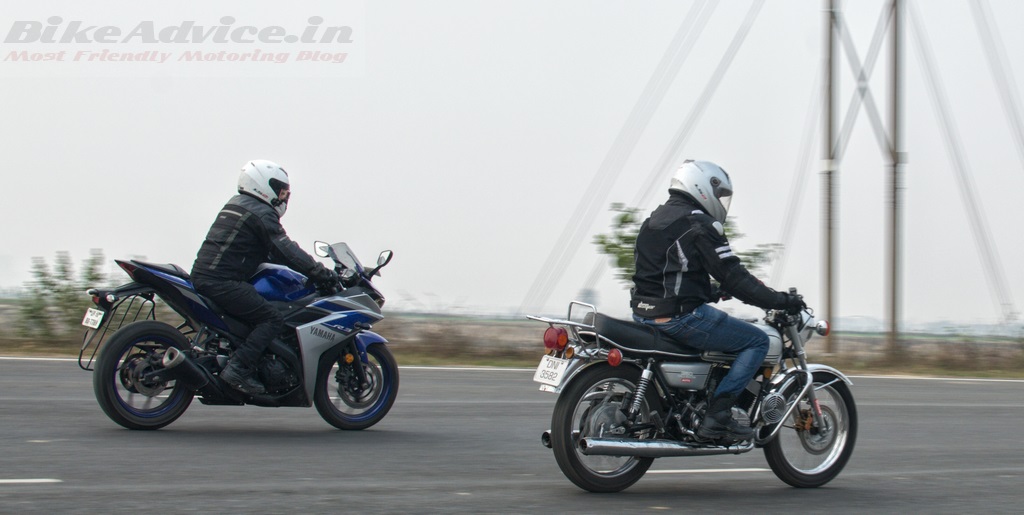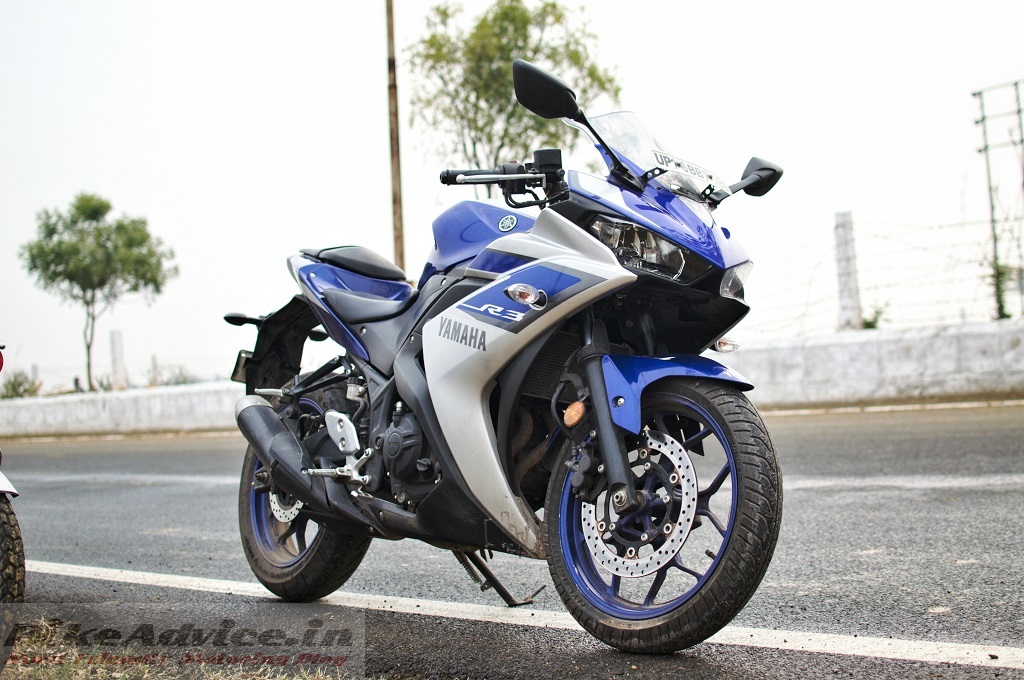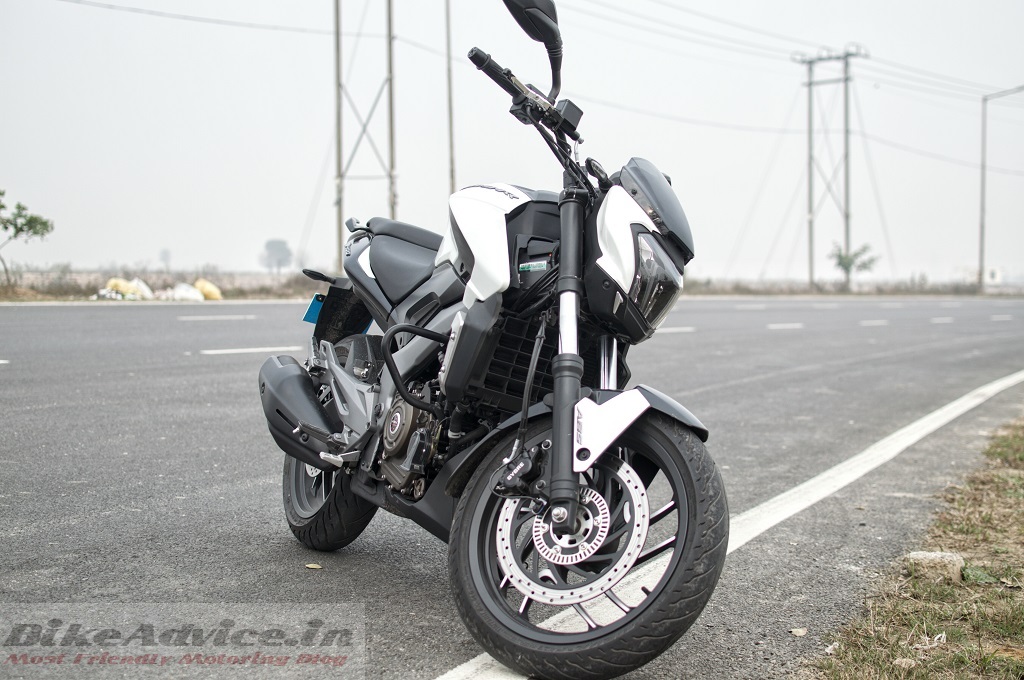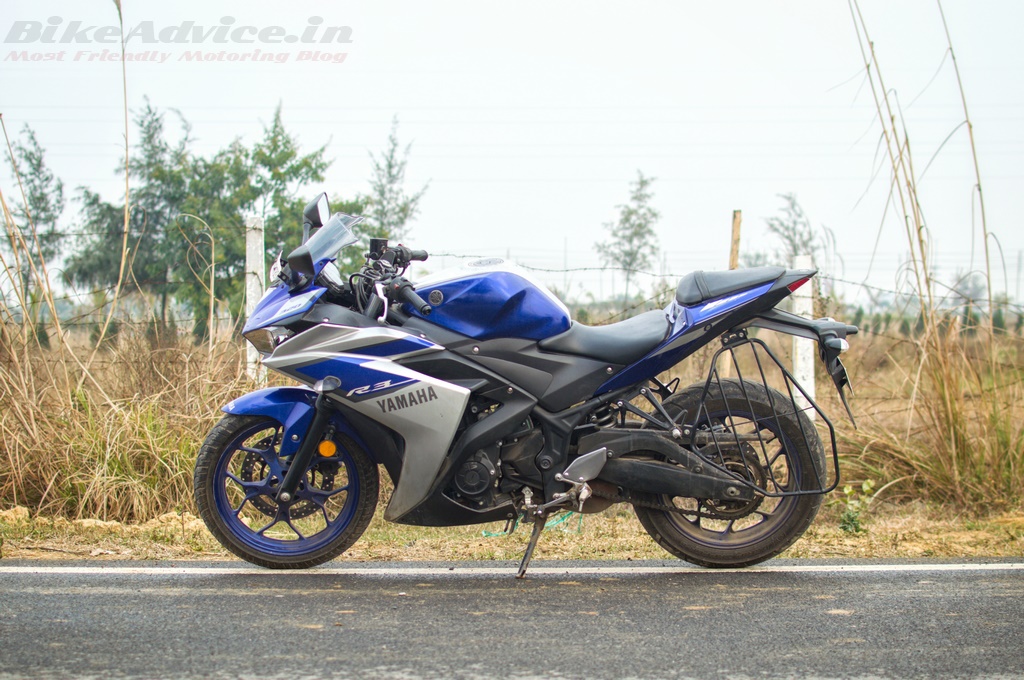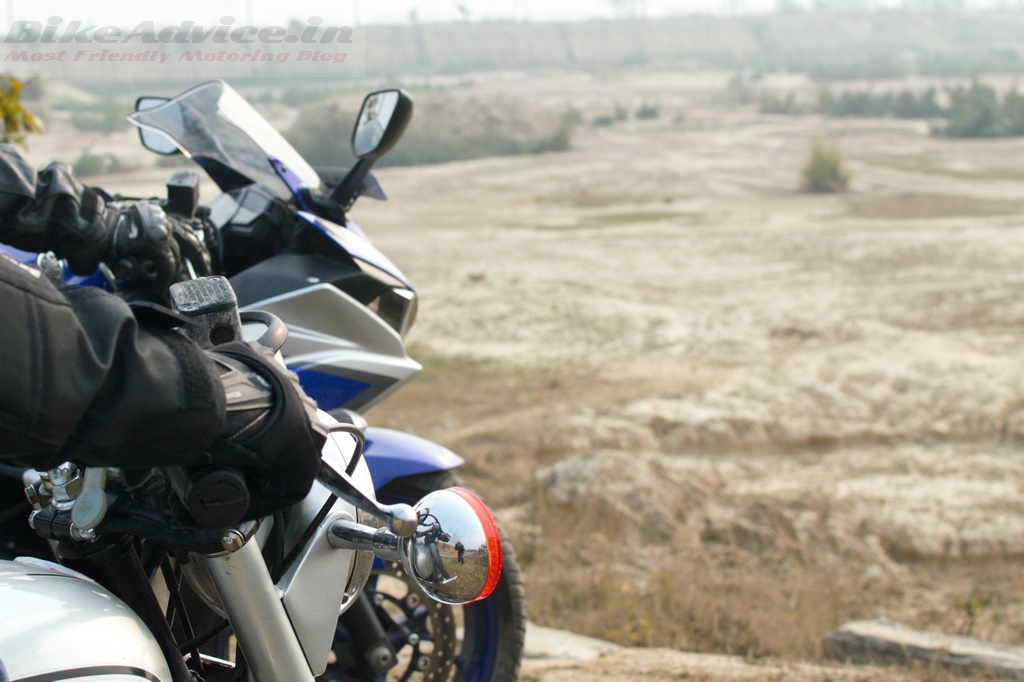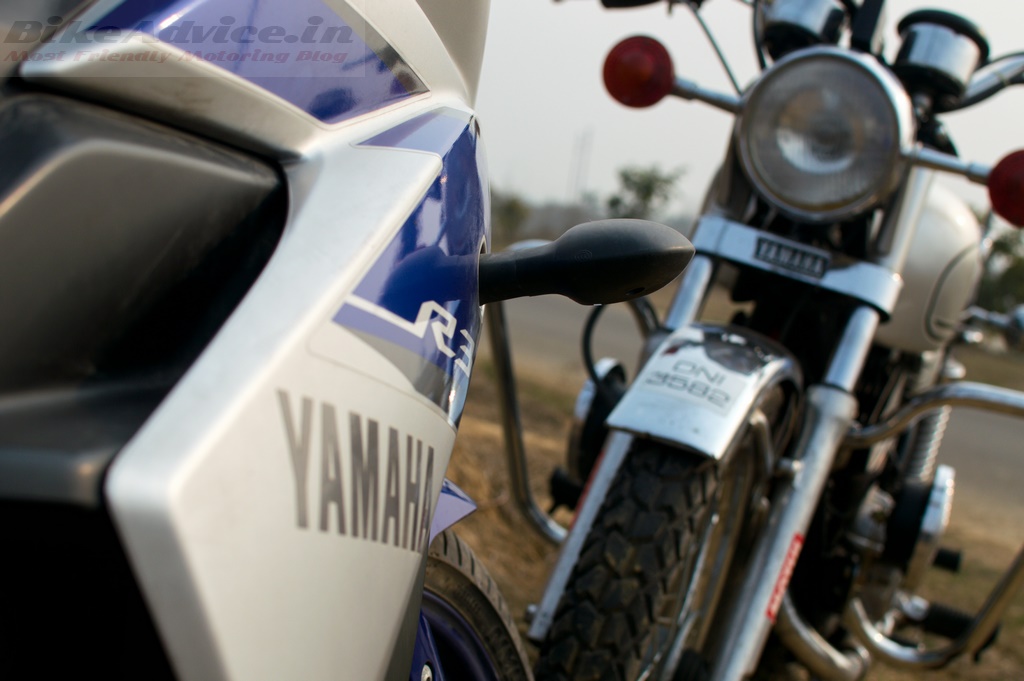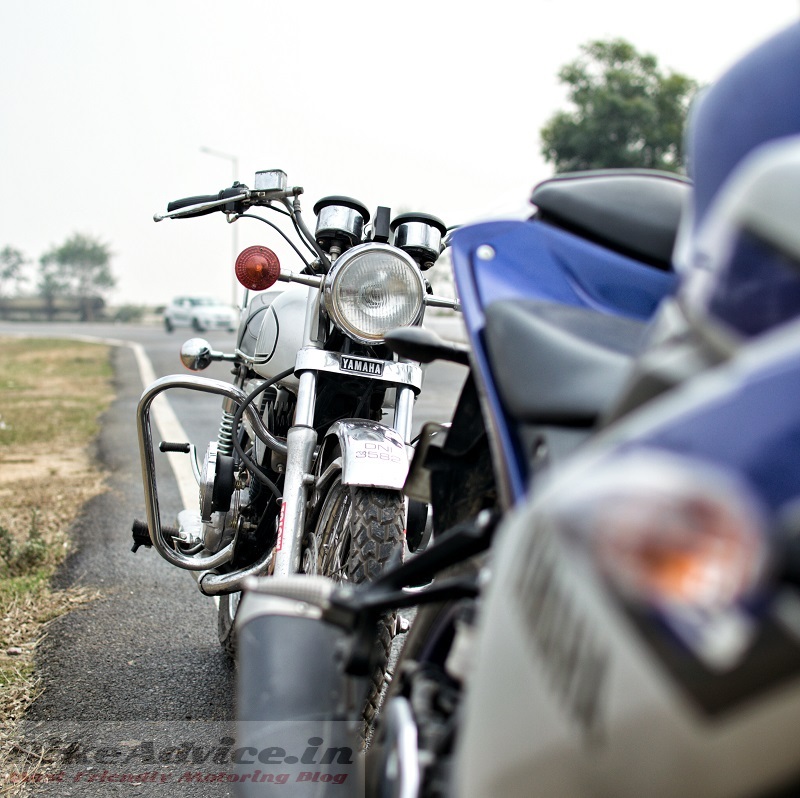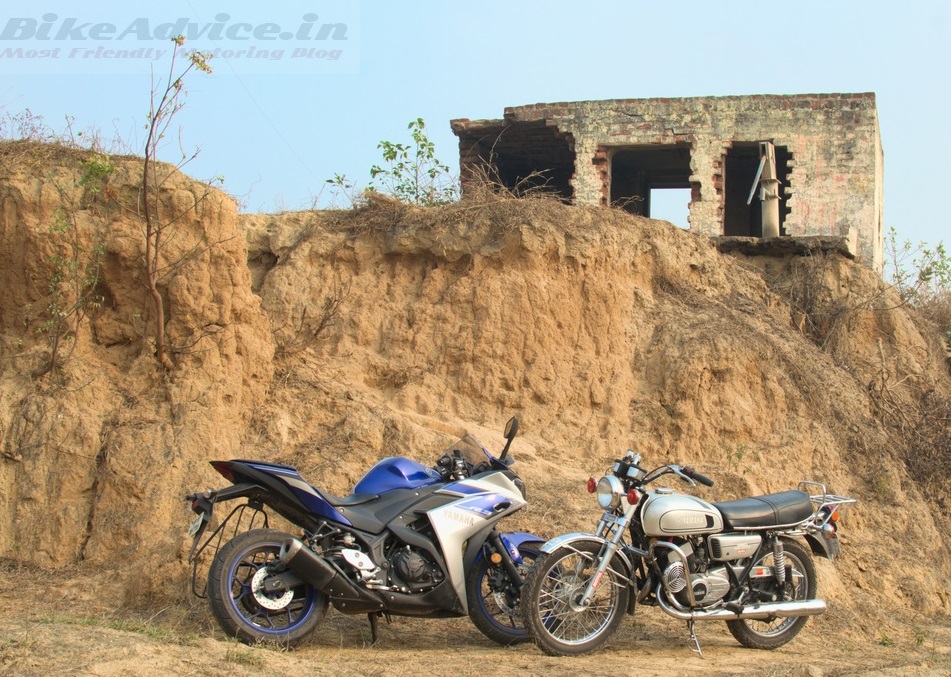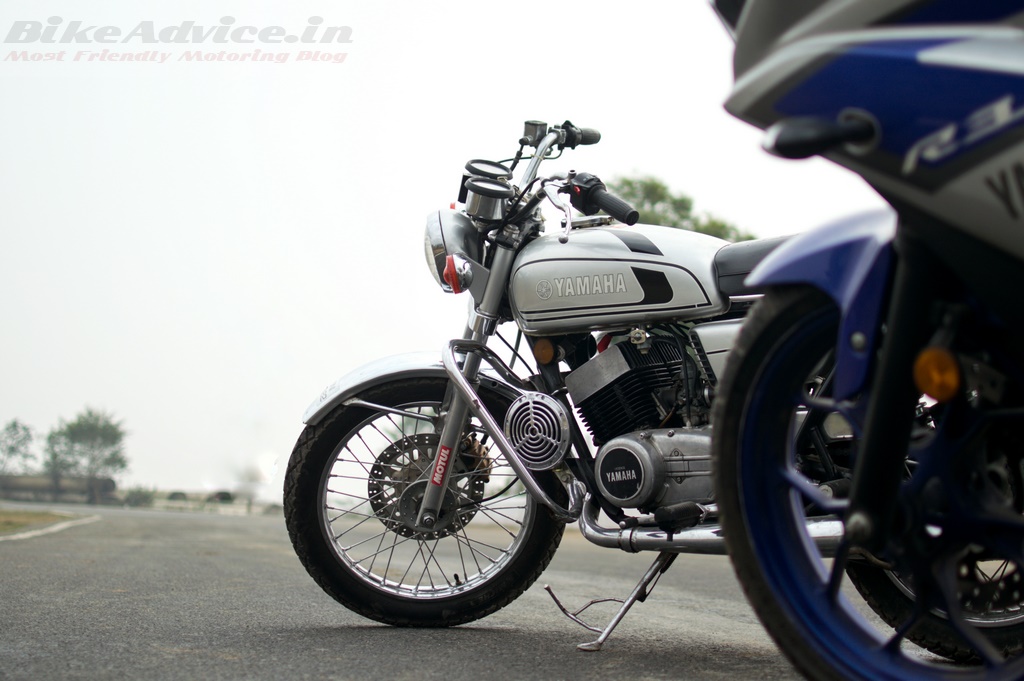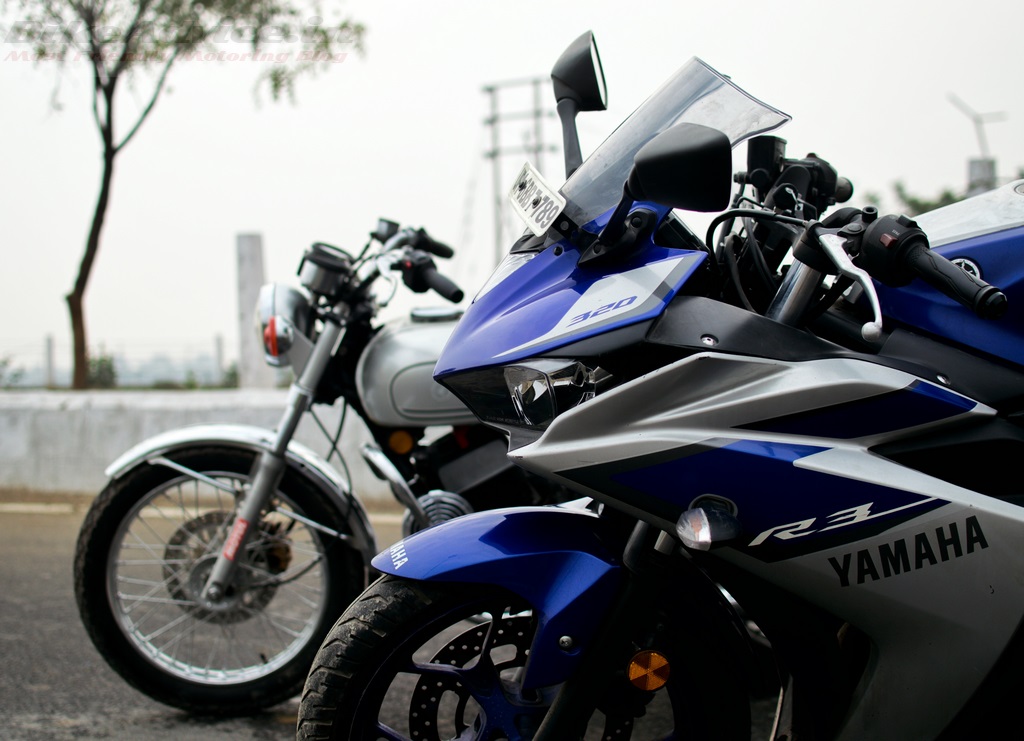R3 vs RD350: Words: Syed Shiraz Photography: Akshay Sharma Yamaha RD350: Nadeem Ashraf
Yamaha YZF-R3: Yamaha India
This is something that I have been wanting to do ever since we rode the YZF-R3 at its launch at the BIC in 2015. It’s not common for bike manufacturers in India to launch their products at a full-fledged racetrack, but for a manufacturer that entered racing the very same year it produced its first bike, it seemed like sheer common sense. Yes, Yamaha produced its first motorcycle, the two-stroke YA-1, in 1955 and in the same year the bike not only just participated in races but also emphatically won the 125 cc class in both the race events it participated in!
Anyway, Yamaha had also brought John Abraham – a BIG (pun intended) fan of the RD350 himself – at the R3 launch event, who spoke about how the R Series family in India was now complete with the R3 joining the R15 and the R1. Of course, his statement was not entirely correct as the R6 is nowhere in the picture (in India) as yet, but, other than that, I was almost miffed to learn that he did not say anything about the original R series of Yamahas, the RDs, especially the “Giant Killer” – the RD350. But I somehow feel that even his subconscious must have thrown an image or two of the RD while talking about the new twin-cylinder Yamaha; his professional obligations warranting forbearance…
Now, please allow me to digress a little here and shatter the popular notion that the letters ‘RD’ in RD350 stood for Race Derived / Race Developed. No sir, they NEVER meant that! RD, DT, XS, etc., actually just denoted how the motorcycles were classified by Yamaha. RD meant “two-stroke road”; DT signified a “two-stroke trail” bike, and if you saw XS written on a Yammie it meant you were looking at a “four-stroke touring” Yamaha. Which also means that despite 98 per cent of the Indian automotive blogs and websites telling you recently that not only does something like an XSR 300 exist, it’s the reincarnation of the RD, YOU, dear reader, are the wiser.
Okay, if bursting the race-derived bubble broke your heart, it shouldn’t have. Because, I am not alienating the RD from Yamaha’s rich, and very successful, racing heritage. On the contrary, I am reiterating the inseparable connection between the two. See, Yamaha had never been a company that first made sissy bikes for years; dabbled into racing one fine day; won by fluke, and then claimed to have brought race technology to their street bikes. The way they worked from the beginning was something like this: produce a fast and reliable bike – race it –WIN– improve the bike further – race it –WIN– repeat. So as much as their race experience taught them to continually make their road bikes better, the road bikes themselves were good enough to begin racing with at the first place!
With such pedigree to live upto, the R3 was never going to have it easy. More so in India where every performance-oriented bike launched ever since the first CBZ in 1999 to the Pulsars, Karizmas, Natashas, etc., irrespective of cubic capacity, was compared to the RD. Naturally then, when Yamaha themselves launch a twin-cylinder motorcycle in India, the comparisons are inevitable.
I consider myself fortunate enough to own two RDs (that’s how four out of five bikes in my garage are Yamahas), an ‘88 LT and an ‘83 HT (yes, from the initial lot – production serial no. 312), and though both my RDs are in top nick engine-wise, cosmetically they look how more than 30 year-old bikes should look. They are NOT shiny. In fact, forget ‘shiny’, my RDs wear their scars with such disdain that it looks like they had been in many a street fight all throughout their youth, and that though they might have matured, they haven’t forgotten to throw down.
But they are not from the Facebook generation, so they do not like to pose. Hence, I had to ask my younger cousin, Nadeem Ashraf, to bring his fully restored specimen for this shoot. He has a few other lovelies in his collection, but that is a story for some other day.
Now as soon as we parked the bikes and took our helmets off, I noticed something. We had parked the bikes casually, oblivious of the fact that by doing so we had unknowingly made a frame that presented a view not seen everyday.
The picture not only shows three Yamahas in the exact chronological order of their launch in India, but also silently depicts the four-stroke R Series’ admiration of their progenitor. So we clicked one more picture with Akshay’s R15 for a reader who had requested one long ago upon seeing the pictures of the R3 with my R15 in the former’s review story. This one is for you, mate.
And then it was time to pit the twins against each other…
It all starts with the looks, doesn’t it fellas? Here, with the RD vs R3, it’s entirely about honest-to-goodness appeal versus flamboyance; simplicity versus flash; raw versus, er, processed. I have mentioned this in more than one story earlier that it’s the RD that comes to my mind when I hear the word “motorcycle”. For some, that imagery might comprise a faired bike, while a cruiser is what the rest of them would imagine upon hearing the word. For me, it is the RD.
That simple round headlamp, the twin analogue pods, the perfectly bulbous fuel tank, the tightly packed engine compartment, the subtle race fins on the side panels, the almost organic pipes, the long stalk
metal indicators, the wide handlebars (I can go on!); heck, everything about the RD makes it look like an exemplar of the word motorcycle! I now vaguely remember a school text book for toddlers where the chapter on the English alphabet showed that the letter M stands for Motorcycle and the RD’s picture was used as illustration. That’s education done right.
The RD is a brutally honest machine; it comes with no pretense whatsoever. Its heart (engine, for the uninitiated) is out there in the open for everyone to see and size up their competition. The R3, in striking contrast, is a little enigmatic. In fact, it’s perceived as a bigger bike by onlookers, who seldom notice the subtle 320 decal. I am sure they get mesmerised by those eyes. And what eyes they are! Akshay and I are in love with them. The R3 doesn’t mind it.
Again, it’s the R3 that has the sharpest and the most beautiful face of all bikes in the segment. Not just in the segment I say; I feel that it also happens to be the most beautiful R Series Yamaha currently on sale. See, as far as only the looks are concerned I am not a fan of the latest R1, R6, and R15 models. Of course, they are getting better technologically, but, sadly, their beauty quotient has depleted at an inversely proportional rate. If you ask me, the most beautiful R1s were produced from 2000 to 2008; the R6s from 2003 to 2005; the best-looking R15 is the current one on sale in India, and, it looks like the R3, thankfully, will keep Whigfield’s ‘90s hit playing on in our minds for a long time to come.
So it’s a tie in the visual department. The RD looks like that Greek God who runs barefoot on the beach in swimming trunks, whereas the R3 is that supermodel who works the treadmill in Nike Jordans at the Gold’s Gym. Take your pick.
But how are these twins to ride?
The Greek God here is an MMA fighter, that too a temperamental one. The supermodel, again in striking contrast, is a Tai Chi disciple. You wouldn’t want to cross the path of either…
This RD LT produced 27 hp when it was new. Its peak power output at present is anybody’s guess, but it does not even matter. Because, even after all these years, a well-timed (ignition timing) RD350 like this one, under hard acceleration, will have the front wheel making vertical progress in the first three gears despite the rider’s best intent to keep the charge as horizontal as possible. The rush is like nothing you’ve ever experienced before – especially if you’re someone whose first bike was a four-stroke. The first time you ride an RD350 the way it’s supposed to be ridden, even for fifteen minutes, irrespective of your skill set, you’re overwhelmed. You stop the bike on the shoulder, kill the engine, push the side stand out, and dismount. You realize that your hands tremble, your legs shake, and the hair at the back of your neck is still erect. You now understand the stories of the RD getting people to look up ‘whiplash’ back in the ‘80s and ‘90s, were true. You contemplate for a few more minutes, muster up courage, and kickstart the beast again to get one more shot of adrenaline. You’re now hooked for life.
The R3, in comparison, is peaceful. Fluidity is the operative word with this Yamaha. You remember the Tai Chi reference above, right? Yes, the R3 is that guy with a calm demeanour who gets along with all kinds of people. Which basically means that almost anyone and everyone will find the R3 a friendly machine – it’s that easy to ride. And I am not just only referring to the low saddle height here (which, at 780 mm is 15 mm lower than that of the R15), but since I have touched it, I’ll talk about the brilliant ergonomics of the R3 first, and then tell you the additional attributes which make it an approachable machine for all.
See, the R3 has the most comfortable ergonomics I have yet experienced on a sportbike. Yes, you read that right. Yamaha have achieved the impossible with the ergonomics of this motorcycle. Why do I say that? Well if a 6’3” Akshay, who feels cramped on his R15, exclaims that he is much more comfortable on the R3; if Nadeem (5’7”), whose daily ride is a Karizma, says that he FEELS more in command on the R3; if Sayan (5’10”), who rides to the shoot on a brand new Dominar, but requests to ride the R3 (despite riding it his heart’s content last year) just to the change the bad taste in his mouth left by that Bajaj; and also when
I, a five-footer, find the R3 to be the most comfortable bike I have yet ridden, then sir I definitely have more than enough reasons to say that the R3 is leagues ahead of its competition in this department. Other manufacturers can learn from Yamaha that one can make comfortable bikes for taller people without making the perch unmountable for shorter riders! It’s the same case with the RD, as I am yet to come across someone who says that the bike is too big or too small for his stature. The RD does one thing better here though – it carries the pillion in far more comfort than the R3. That said, your girlfriend/wife will be more comfortable riding pillion on the R3 than on the Ninja 300. The RC390 guy should not even have a girlfriend…
Coming back to the ease of riding, it’s the super smooth power delivery and the light clutch, in addition to the comfortable ergos, that got me to make that statement. So if you are someone who has the money, but was sensible enough to first learn the ropes on a used RX-100, you may buy the R3 straightaway. It won’t scare you. The RD WILL. But don’t even for a moment think that the R3 is not quick or fast. How quick and fast? Well, I’ll get to that in a bit; right now I’ll just tell you it is quicker than the Ninja 300 and you already know the top whack I managed at the BIC. So, yes, it would take you to your Greenpeace meets much quicker than you’d expect.
But how does it stack up against the RD?
See, the 39 hp RD350 in the USA was tested back then to go from zero to 150 km/h in around 15 seconds before reaching its top speed, which was a shade more than 170 km/h (106 mph). Its best quarter-mile time was 14.12 seconds., which, more often than not, was enough to beat the 120 mph 650 cc Triumph T120s at the drag strips. Now look at the video clip below for a couple of times and note down the 0-150 km/h time of the R3. Like us, you would be pleasantly surprised as well.
See, the R3 has a power-to-weight advantage (it’s little, but it’s there) over the American RD, but it still took the R3 exactly 15 seconds to hit 150 km/h from a standing start! That’s what happens when you need twice the amount of crankshaft rotations to achieve one power stroke… The RD must be laughing right now.
But the stock Indian RDs, with 30.5 hp (HT) and 27 hp (LT) are way down in the horsepower-per-tonne stakes when compared to the R3, so if you felt that the Indian RD would win the drag race with the R3, now is the time to take off your 2T-stained glasses.
You would have already noticed that we still did drag the RD with the R3, but, thankfully, Nadeem braked within the first 100 meters when he saw a Nilgai darting across the finish line ahead! Don’t ask me where we were shooting this; it would just suffice to tell you that we did not want to give it another shot…
So, the R3 is both quicker and faster and quicker than our beloved RD. And it should be. If a current generation motorcycle is not quicker and faster, among other things, than its counterpart from more than three decades ago, it would be a shame – these are Yamahas, people, not Royal Enfields.
That said, it would not take much for the Indian RDs to destroy the collective happiness of the R3, Ninja 300, and RC390, with just a few tweaks. And it’s common knowledge by now that fully-modded RDs have been making even the liter-class missiles eat dust at the drag strips! Yes, in India as well. But stock versus stock, the new Japs and the Austrian have finally bettered the ‘80s performance game in India. After more than 30 years. The RD must again be laughing…
But there is one thing that these new kids on the block will never be able to match – the sonorous sound of the RD350! Forget the R3, or the Ninja 300 – not even the Ninja 650 is a patch on the RD in the acoustics department. And you deserve to be shot at sight if you dare to even mention the KTMs here. I still remember (2009 I believe it was) one of my best buddies (who has owned quite a few superbikes, and also happens to be a great friend of the founder of a certain online biking community) mentioning, “looks like a big bike is coming…” upon HEARING a distinct roar travelling in his direction, while he was taking a stroll after dinner outside our office post 11 pm. That was yours truly riding to work on his RD. Oh yes, we used to work night shifts back then.
This is one thing that no small capacity four-stroke twin will ever be able to manage. No, not getting people to and from work in night shifts; I am referring to the glorious sound of the RD350. Here, listen to it in one of my old casual videos:
I’ll stick my neck out and say that even none of the bigger four-stroke parallel twins sound as good. Only the inline threes and fours sound better. Okay, I hear that the Benelli 300 sounds fantastic as well, but I have also heard that it holds the trophy together with UM Motorcycles and Royal Enfield as the worst bikes to be sold in India. Coincidentally, none of these manufacturers have yet been able to provide a test bike to us to prove otherwise.
I must also mention here that though the RD featured in our story features a front disc brake and ‘Yamaha’ decals, the bike never came with either in India. The Indian RD had Rajdoot (there are some who still think that RD is short for Rajdoot) stickers, while its front brake was a big (7-inch, no pun is intended here) drum, but it was a twin leading set up, as compared to the single leading type that you still see on all drum-brake variants sold in India. The difference is that instead of one cam pushing the brake shoes against the drum when you squeeze the lever, the RD’s unit has two cams for the same job. The result is quicker and better (even) expansion of brake shoes.
Of course, that still does not justify the omission of the solid 10.5-inch rotor, which the American RD had, but the brakes are not at all as bad as projected by almost all Indian bloggers/journos in their articles. The problem is – a few of these ‘experts’ have never even ridden an RD. Obviously, the R3’s brakes are phenomenal in comparison. In fact, they are much, much better than the KTMs’.
Both the Yammies here handle beautifully without breaking the back of the rider like the KTMs, but I would like to highlight something that I feel has again always been missed by all in the context of the RD. See, most of us forget that while the RD in India became famous majorly for its outright performance, the first American RD was called a giant killer due to its sublime handling, both on the racetracks and on the twisties, and not for the horsepower it produced. Fast forward forty years and we have the best track tool in the form of the RC390, with the R3 following close behind, but, will these two ever be able to beat, say, something like the Daytona 675 or even the Ninja 650 the way the RD used to beat the 600s, 650s, and even 750s? I doubt it.
That’s why, I guess, I just couldn’t stop thinking about the Rocky movie series while writing this article. The journey of the RD is not dissimilar to Mr. Balboa’s – they both could punch a lot above their weight; they both saw their hard times, but bounced back up to decimate all, and even way after retirement they both gave the new established champions the toughest fight of their lives. Like Stallone was told in the movie – you’re all heart, Rock! – I would have the exact same words for the RD. That is why, even after four decades, the new ones may match it in performance, but they would never be able to match it in spirit!
Next Read: ‘Why Hero is in Danger & May Get Lost’ – Analysis by BA Reader from IIM

